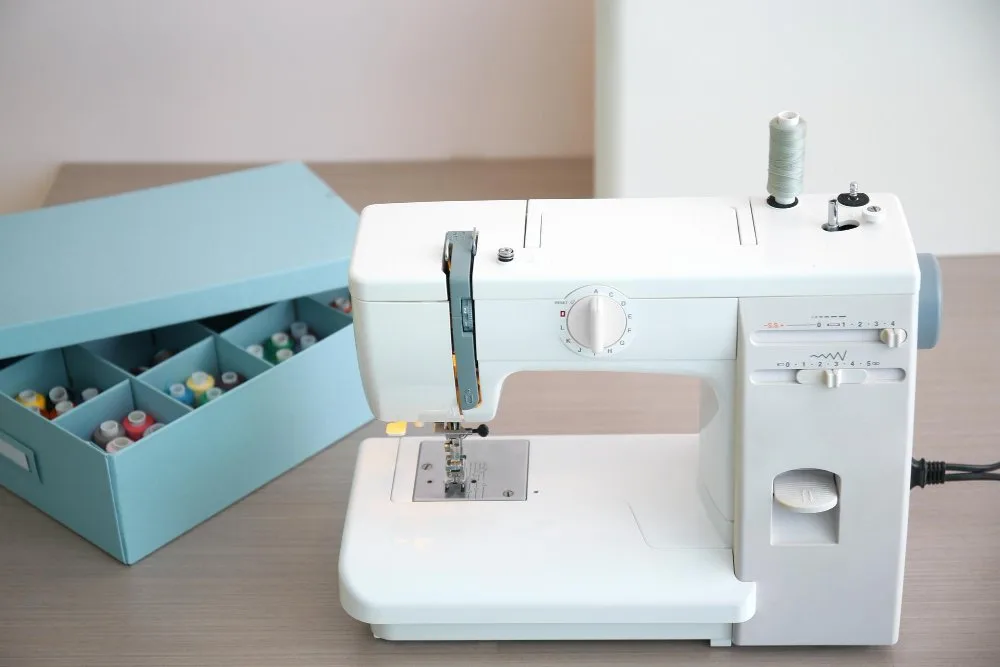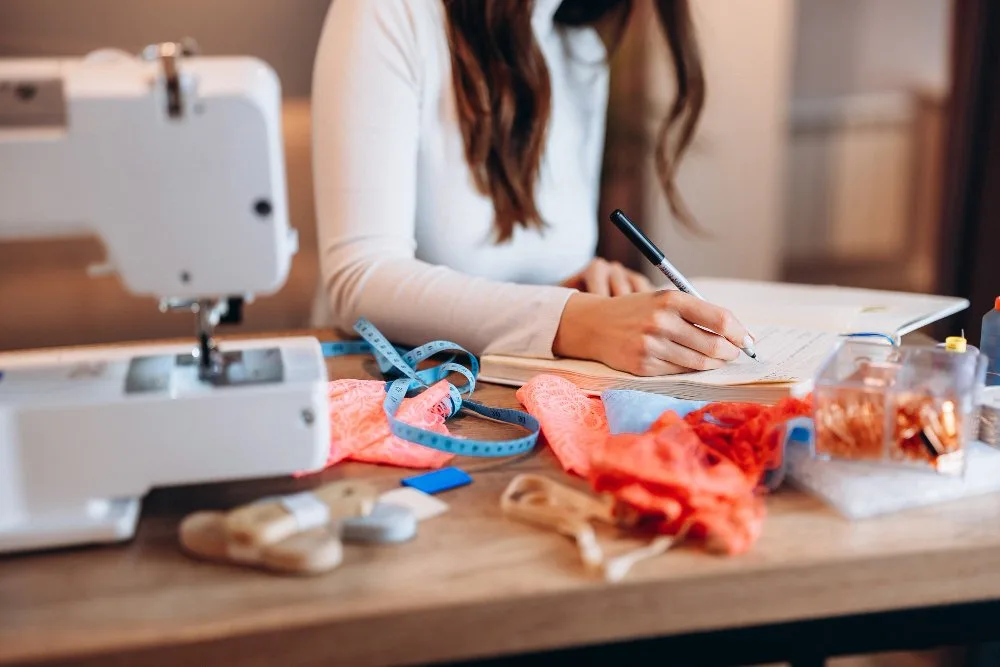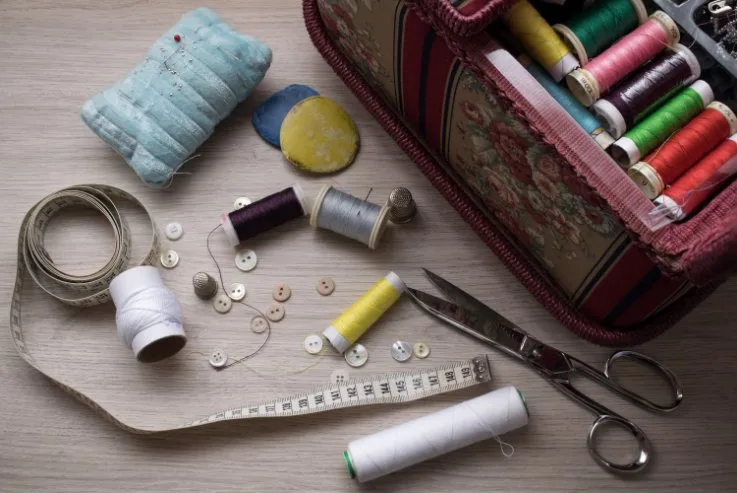Table of Contents
- Understanding Your Sewing Goals and Needs
- Top 5 Beginner Sewing Machine Recommendations
- Types of Sewing Machines Explained
- Must-Have Features for Beginners
- Budget Guide and Value Considerations
- How to Test Drive Your Future Machine
- Maintenance and Troubleshooting Guide
- Essential Accessories and Attachments
- Best Sewing Machine Brands Compared
- What to Buy With Your First Machine
- Frequently Asked Questions
Creating beautiful garments or home decor has never been more popular. Whether you want to mend clothes, design quilts, or experiment with different fabrics, choosing the right sewing machine can make all the difference. This comprehensive guide will help you navigate the overwhelming world of sewing machines and find the perfect match for your creative goals.
Current 2025 Market Insights
The sewing machine market has evolved significantly in 2025. Modern fabrics demand more sophisticated handling, while supply chain improvements have made quality machines more accessible. Key trends include:
- Improved automation: Even budget machines now include automatic threading
- Better LED lighting: Standard across most 2025 models
- Enhanced durability: Metal components now common in $200+ range
- Smart features: USB connectivity and app integration in premium models
Understanding Your Sewing Goals and Needs
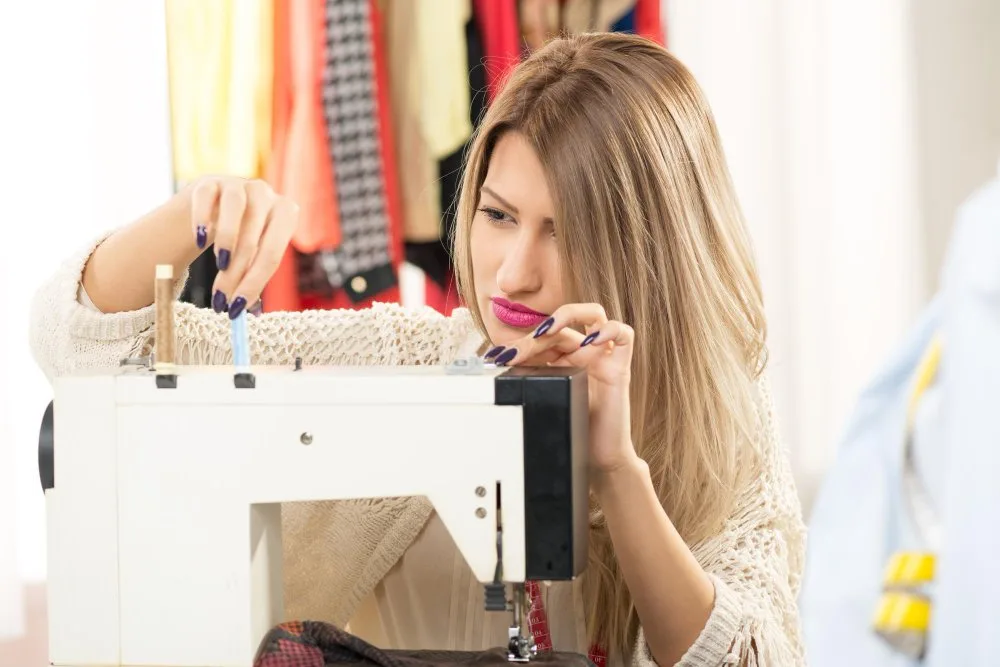
Before diving into specific models, take a moment to assess your sewing aspirations. The clearer you are about your goals, the better equipped you’ll be to make a smart purchase.
What to Look for When Buying a Beginner Sewing Machine
Start by asking yourself these essential questions:
- How often do you plan to sew? (Daily, weekly, or occasionally)
- What types of projects interest you most? (Garments, quilts, home decor, repairs)
- What fabrics will you work with? (Cotton, denim, stretchy fabrics, delicate materials)
- How much space do you have for sewing?
- What’s your comfort level with technology?
Identifying Your Projects and Fabric Types
Different projects require different machine capabilities. Here’s a quick breakdown:
| Project Type | Common Fabrics | Key Features Needed |
|---|---|---|
| Quilting | Cotton, Batting | Extended workspace, walking foot, even feed |
| Garment Making | Knits, Stretch, Woven fabrics | Stretch stitches, buttonholer, multiple foot options |
| Home Decor | Canvas, Upholstery, Heavy materials | Powerful motor, thick needle support |
| Repairs & Alterations | Mixed materials | Basic stitches, easy threading, reliable performance |
Top 5 Beginner Sewing Machine Recommendations for 2025
After extensive research and testing, here are the best sewing machines for beginners, each offering excellent value and performance:
1. Brother HC1850 – Best Overall
Price Range: $200-250 Mid-Range
Why it’s perfect for beginners: The Brother HC1850 combines user-friendly operation with professional-grade features. It offers 185 built-in stitches, automatic needle threading, and an LCD display that makes stitch selection simple.
Key Features:
- Easy-to-follow threading guides
- Drop-in bobbin system
- Instructional DVD included
- Wide table for larger projects
- Excellent stitch quality on various fabrics
2. Brother XR9550 – Best Value
Price Range: $250 Mid-Range
Why it’s great: This computerized machine offers incredible value with 165 stitches, clear LCD screen, and speed control. Perfect for beginners who want room to grow.
Key Features:
- 165 built-in stitches including decorative options
- Clear LCD display for easy stitch selection
- Automatic needle threader and threading system
- Wide extension table for quilting projects
- Speed control slider for precise control
- Drop-in bobbin system
- Free arm for circular sewing
3. Brother CS7000X – Most User-Friendly
Price Range: $230-260 Mid-Range
Best for: Complete beginners who want comprehensive accessories. Comes with 70 stitches, hard case, and extensive accessory kit including 10 presser feet.
Key Features:
- 70 built-in stitches with LCD display
- Automatic needle threader
- 10 included presser feet
- Hard protective carrying case
- Wide extension table included
- Instructional DVD and manual
- Free arm and drop-in bobbin
4. Singer Heavy Duty 4423 – Best for Thick Fabrics
Price Range: $180-220 Budget
Perfect for: Beginners planning to work with denim, leather, or multiple layers. Features a powerful motor and metal frame construction.
Key Features:
- Heavy-duty metal frame construction
- 60% stronger motor than standard machines
- 1,100 stitches per minute capability
- 23 built-in stitches including stretch stitches
- Automatic needle threader
- Heavy-duty needles included (size 16)
- Adjustable presser foot pressure
- Free arm for sleeves and cuffs
5. Janome 2212 – Most Reliable
Price Range: $130-160 Budget
Why choose this: Simple, mechanical operation with exceptional build quality. Perfect for beginners who prefer straightforward controls without computerized features.
Key Features:
- 12 built-in stitches (all essential types)
- Mechanical operation with manual controls
- Front-loading bobbin system
- Adjustable stitch length and zigzag width
- Pre-set tension for most fabrics
- Free arm capability
- Durable metal construction
- 25-year limited warranty
Types of Sewing Machines Explained
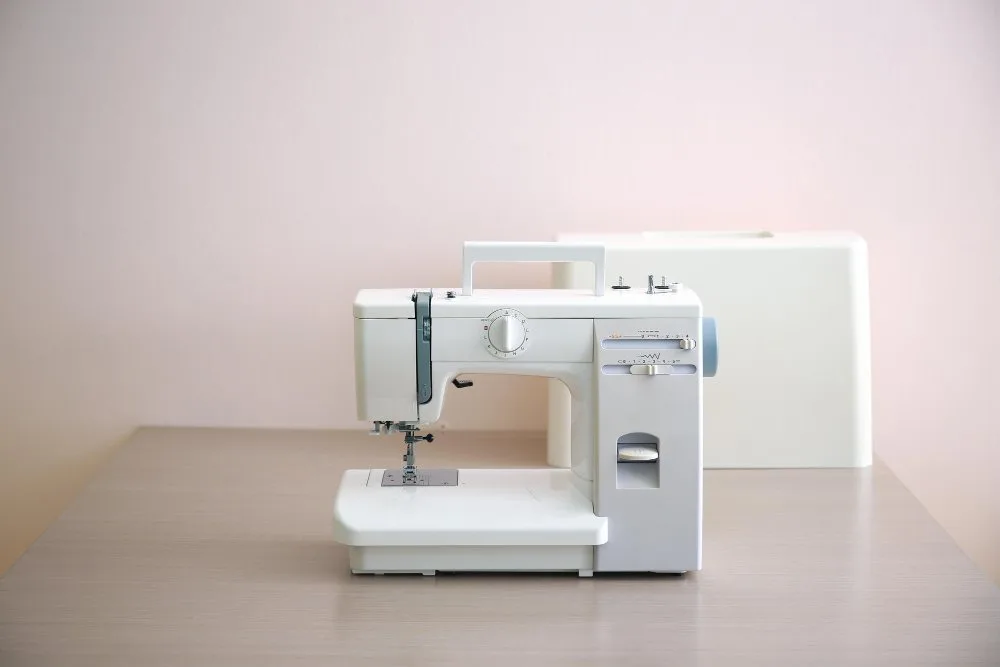
Mechanical vs Electronic vs Computerized
Understanding the three main types helps narrow your choices:
Mechanical Machines
These use physical dials and levers for all adjustments. They’re reliable, affordable, and perfect for learning fundamental skills. With fewer electronic components, there’s less that can break down. Most offer 15-30 basic stitches, which is plenty for most beginners.
Electronic Machines
Electronic models add push-button convenience while maintaining mechanical reliability. They typically offer 50-100+ stitch patterns and preset functions like one-step buttonholes. These strike a nice balance between simplicity and versatility.
Computerized Machines
These feature touchscreen interfaces, programmable stitch sequences, and advanced automation. While powerful, they can overwhelm beginners with complex menus and settings. Consider these only if you’re comfortable with technology and plan frequent, complex projects.
What Does a Serger Do?
A serger (or overlock machine) is a specialized machine that trims, stitches, and finishes seams in one pass. While not essential for beginners, sergers create professional-looking seams and are excellent for knit fabrics. Consider adding one to your setup after mastering basic sewing skills.
Must-Have Features for Beginners
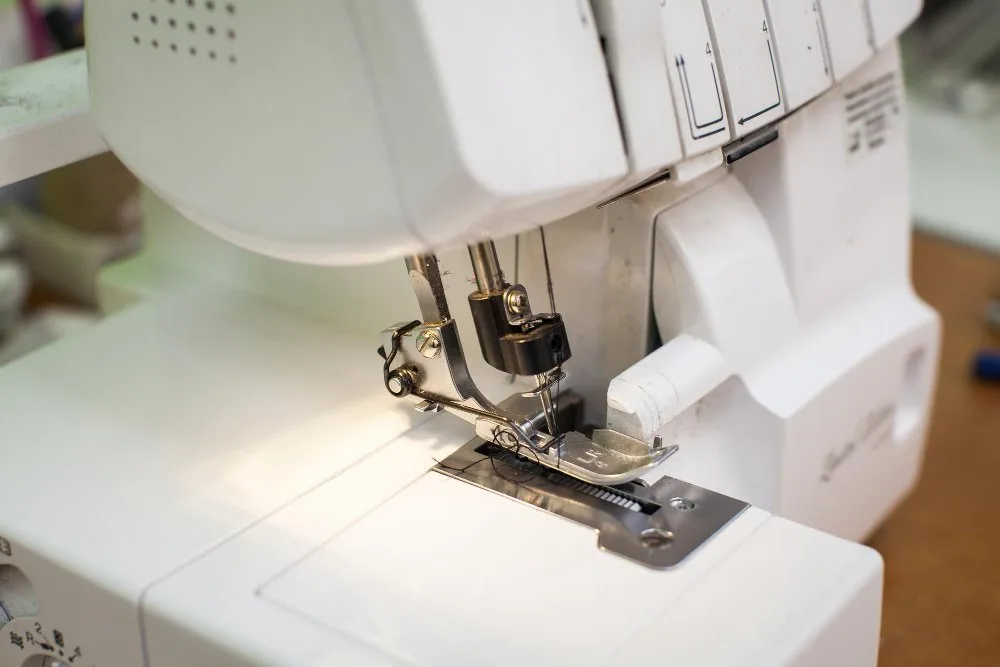
When Selecting a Sewing Machine, Which Feature is Most Important for a Beginner?
The most critical feature for beginners is stitch consistency and quality. A machine that produces even, reliable straight stitches will serve you better than one with 200+ decorative patterns but poor basic performance.
Essential Features Checklist
- Automatic needle threader: Saves time and reduces eye strain
- Drop-in bobbin system: Much easier than front-loading bobbins
- Adjustable stitch length and zigzag width: Basic versatility
- Free arm capability: Essential for sleeves and cuffs
- Multiple presser feet included: Zipper, buttonhole, and all-purpose feet minimum
- Speed control: Helps beginners maintain control
- Good lighting: LED lights work better than incandescent
- Clear instruction manual: Often overlooked but crucial
Features You Can Skip Initially
While nice to have, these features aren’t essential for beginners:
- Hundreds of decorative stitches
- Embroidery capabilities
- Computer connectivity
- Automatic thread cutting
- Memory functions
Budget Guide and Value Considerations
How Much to Spend on a Beginner Sewing Machine
Smart budgeting involves more than just the initial machine cost. Here’s a realistic breakdown:
| Budget Tier | Machine Cost | What You Get | Expected Lifespan |
|---|---|---|---|
| Under $150 | $80-150 | Basic stitches, lightweight construction | 2-4 years with light use |
| Sweet Spot | $150-300 | Metal internals, variety of stitches, accessories | 7-10+ years |
| Premium | $300-600 | Advanced features, superior build quality | 15+ years |
Total First-Year Investment
Budget beyond the machine itself:
- Machine: $150-300
- Essential supplies: $50-75 (threads, needles, scissors, seam allowances tools)
- Additional presser feet: $30-60
- First-year maintenance: $25-50
- Total: $255-485
What’s a Cheap but Good Sewing Machine?
The Brother XM2701 (around $140-160) offers exceptional value. It includes 27 stitches, automatic needle threader, and comprehensive accessories. While not heavy-duty, it handles most beginner projects beautifully and comes from a reliable brand with good support.
How to Test Drive Your Future Machine
Critical Evaluation During Demonstrations
Never buy a sewing machine without testing it first. Bring fabric samples that represent your typical projects and follow this testing checklist:
- Thread the machine completely (top thread and bobbin)
- Test straight stitch on different fabric weights
- Try zigzag stitches at various widths
- Test buttonhole function if included
- Evaluate noise levels at different speeds
- Check stitch consistency and tension
- Assess ease of bobbin winding and insertion
- Test presser foot pressure adjustment
Red Flags to Watch For
- Uneven stitch formation
- Excessive vibration or noise
- Frequent thread breaking
- Confusing or poorly labeled controls
- Flimsy construction that flexes during operation
Maintenance and Troubleshooting Guide
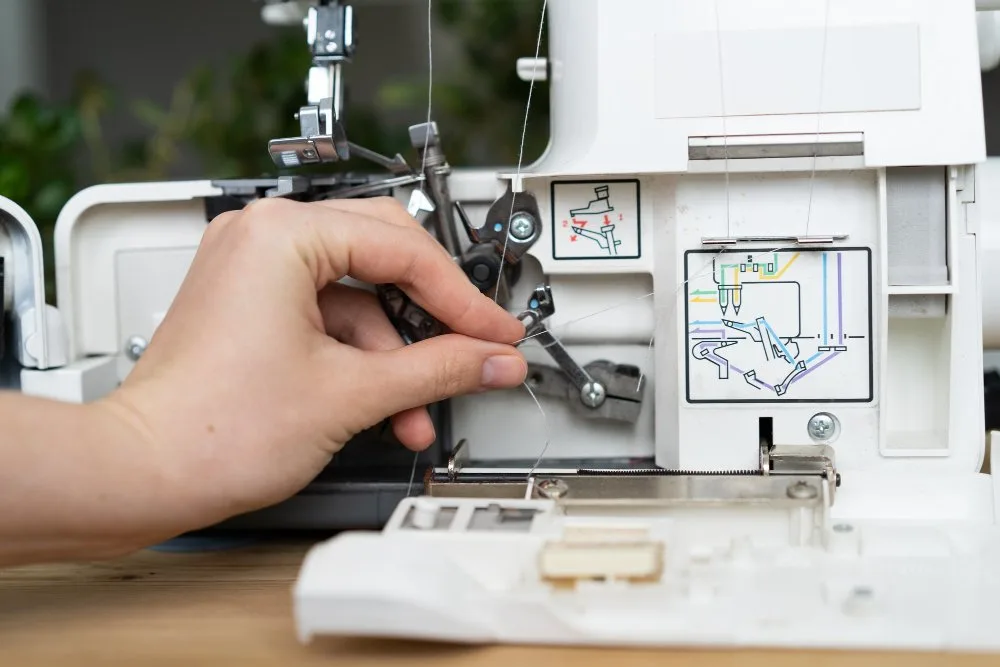
Proper maintenance keeps your machine running smoothly and extends its lifespan significantly. Here’s everything beginners need to know about sewing machine maintenance.
Regular Maintenance Schedule
After Each Use
- Remove lint from needle area
- Cover machine to prevent dust
- Turn off and unplug
Weekly (Heavy Use)
- Clean bobbin case thoroughly
- Remove lint from feed dogs
- Check needle condition
- Oil moving parts (if required)
Monthly
- Deep clean entire machine
- Replace needle
- Check tension settings
- Inspect power cord
Annually
- Professional service
- Internal cleaning and oiling
- Timing adjustments
- Replace worn parts
Common Sewing Machine Problems and Solutions
Most beginner issues are easily fixable. Here are the most common problems and their solutions:
Thread Breaking
Causes: Wrong needle size, poor thread quality, incorrect threading, or dull needle.
Solutions: Re-thread completely, use quality thread, match needle to fabric weight, replace dull needles.
Skipped Stitches
Causes: Wrong needle type, dull needle, incorrect threading, or improper presser foot pressure.
Solutions: Use ballpoint needles for knits, replace needle, check threading path, adjust presser foot pressure.
Uneven Stitches
Causes: Incorrect tension, uneven feeding, or machine needs cleaning.
Solutions: Adjust tension settings, clean feed dogs, ensure fabric flows smoothly.
Machine Won’t Start
Causes: Bobbin case not properly inserted, needle in wrong position, or safety features engaged.
Solutions: Check all connections, ensure needle is fully up, verify bobbin case placement.
For comprehensive troubleshooting steps, check our detailed sewing machine troubleshooting guide, and use our step-by-step troubleshooting checklist to diagnose issues methodically.
Professional Service Networks
Different brands offer varying levels of service support:
| Brand | Service Centers | Turnaround Time | Warranty Coverage |
|---|---|---|---|
| Singer | 1,200+ locations | 3-7 days | 25 years (select models) |
| Brother | 800+ locations | 5-10 days | 2-5 years |
| Janome | 400+ locations | 7-14 days | 2-5 years |
| Bernina | 200+ locations | 5-10 days | 2-7 years |
Essential Accessories and Attachments
What Should I Buy With My First Sewing Machine?
Most machines include basic accessories, but you’ll likely need additional items for a complete setup:
Essential Starter Kit
- Extra needles: Universal, ballpoint, and denim needles
- Quality thread: All-purpose polyester in basic colors
- Fabric scissors: Sharp, dedicated to fabric only
- Seam ripper: For fixing mistakes
- Measuring tools: Tape measure and ruler
- Pins and cushion: For holding fabric pieces
- Marking tools: Fabric chalk or disappearing markers
Understanding Presser Feet
Different presser feet handle specific tasks. Here are the most useful for beginners:
| Foot Type | Primary Use | Priority Level |
|---|---|---|
| All-Purpose | General sewing, straight stitches | Essential (usually included) |
| Zipper Foot | Installing zippers, piping | Essential (usually included) |
| Buttonhole Foot | Creating buttonholes | Essential (usually included) |
| Walking Foot | Multiple layers, quilting | High (often sold separately) |
| Rolled Hem Foot | Narrow hems on lightweight fabric | Medium |
| Blind Hem Foot | Invisible hems | Medium |
What Are Bobbins Used For in Sewing?
Bobbins hold the lower thread that interlocks with the top thread to create stitches. Modern machines use either metal or plastic bobbins. Always use the correct bobbin type specified in your manual, as incorrect bobbins can cause tension problems and poor stitch quality. Keep several bobbins wound with commonly used thread colors.
Do All Sewing Machines Have a Foot Pedal?
Nearly all home sewing machines include a foot pedal for speed control. Some modern computerized machines also offer start/stop buttons as an alternative, but the foot pedal remains the primary speed control method. The pedal allows for precise speed control and keeps your hands free for guiding fabric.
Best Sewing Machine Brands Compared
Is Brother or Singer a Better Sewing Machine?
Both Brother and Singer offer excellent beginner machines, each with distinct advantages:
| Aspect | Brother | Singer |
|---|---|---|
| Best For | Tech-friendly users, versatility | Traditional sewers, durability |
| Price Range | $120-700 (great value) | $100-800 (wide range) |
| Strengths | User-friendly interfaces, good accessories | Heavy-duty options, long history |
| Popular Models | HC1850, XR9550, CS7000X | Heavy Duty 4423, Start 1304 |
| Support | Excellent online resources | Wide dealer network |
Is Janome a Good Sewing Machine?
Absolutely. Janome machines are renowned for superior build quality and reliability. While slightly more expensive than Brother or Singer, they often last decades with proper care. The Janome 2212 is particularly popular among beginners for its simplicity and robust construction. Janome machines typically have:
- Superior stitch quality and consistency
- Durable metal construction
- Excellent customer support
- Higher resale value
Is Janome Better Than Brother?
Both brands excel in different areas:
Choose Janome if you value: Maximum durability, superior stitch quality, and don’t mind spending more upfront for long-term reliability.
Choose Brother if you want: Better value for money, more features per dollar, and modern conveniences like LCD displays and extensive stitch libraries.
Other Notable Brands
Is Baby Lock a Good Sewing Machine?
Baby Lock machines are excellent, particularly for serging and advanced features. However, they’re typically more expensive and may be overkill for beginners. Consider Baby Lock after mastering basic skills and wanting to upgrade.
Bernina: The Premium Choice
Bernina represents the top tier of home sewing machines. While excellent, most models exceed beginner budgets and needs. The precision and features are outstanding, but beginners rarely utilize the advanced capabilities that justify the premium price.
Safety Features and Considerations
Modern sewing machines include several safety features that beginners should understand:
- Needle guards: Prevent finger injuries during operation
- Automatic shut-off: Stops machine if thread jams occur
- Speed limiters: Prevent runaway stitching for beginners
- Secure bobbins: Prevent loose bobbins from causing jams
- Stable construction: Prevents tipping during high-speed operation
Seasonal Buying Strategy
Timing your purchase can save significant money. Here’s when to buy:
| Season | Discount Range | Best For |
|---|---|---|
| Back-to-School (Aug-Sep) | 20-35% off | Student discounts, bundle deals |
| Black Friday/Cyber Monday | 25-40% off | Highest discounts, limited quantities |
| Mother’s Day | 15-30% off | Gift promotions, accessory bundles |
| End of Year Clearance | 20-45% off | Previous year models, floor samples |
Getting Started: Your First Projects and Sewing Kit
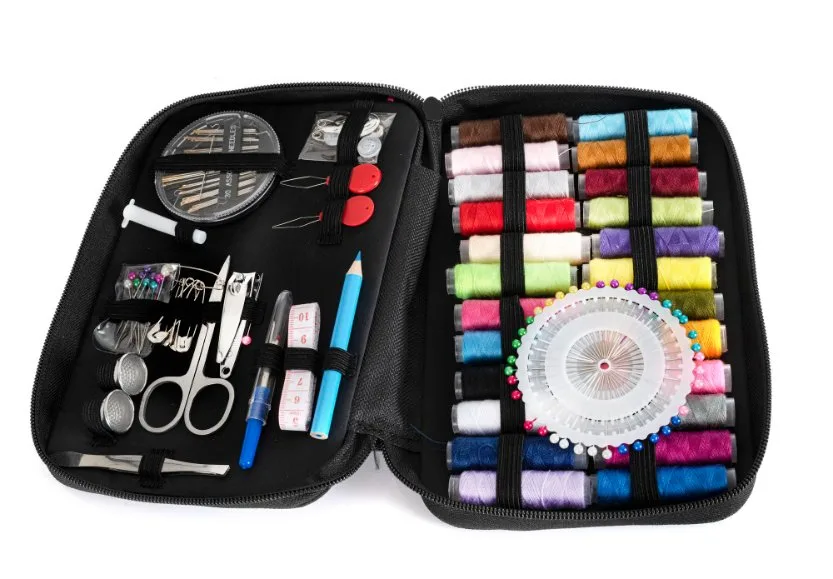
What is the First Thing a Beginner Should Sew?
Start with these beginner-friendly projects that teach fundamental skills:
Perfect First Projects
- Fabric coasters: Practice straight stitches and corners
- Simple tote bag: Learn seam allowances and bag construction
- Pillowcase: Master straight seams and French seams
- Elastic waist skirt: Introduction to curves and elastic
- Basic apron: Combine multiple techniques
What is the Easiest Material to Learn to Sew?
Medium-weight cotton fabric is ideal for beginners. It’s forgiving, doesn’t fray excessively, and holds its shape well. Quilting cotton is particularly good for first projects. Avoid these challenging fabrics initially:
- Stretchy fabrics (require special techniques)
- Silk (slippery and expensive for mistakes)
- Very lightweight fabrics (difficult to handle)
- Leather or vinyl (require special needles and techniques)
What Should Be in a Beginner Sewing Kit?
Beyond your machine, assemble these essential tools for a complete beginner setup:
- Cutting tools: Fabric scissors, paper scissors, thread snips
- Measuring: Tape measure, clear ruler, L-square
- Marking: Fabric chalk, water-soluble markers
- Pins: Glass head pins, safety pins, magnetic pin cushion
- Hand sewing: Hand needles, thimble, small scissors
- Pressing: Iron, ironing board, pressing cloth
- Threads: All-purpose polyester in white, black, and basic colors
- Notions: Buttons, zippers, elastic, bias tape
How to Learn Sewing Machine for Beginners
Follow this structured approach to master your machine:
- Read the manual completely before first use
- Practice threading until you can do it confidently
- Start with paper to practice straight lines and curves
- Test different stitches on fabric scraps
- Learn tension adjustment through experimentation
- Take a beginner class if available locally
- Join online communities for support and tips
Can I Learn Sewing on My Own?
Absolutely! Many successful sewers are self-taught. With quality online tutorials, comprehensive manuals, and practice, you can master sewing independently. However, consider taking at least one beginner class to establish proper habits and get personalized guidance on your specific machine.
Advanced Considerations
What is the Best Heavy Duty Sewing Machine for a Beginner?
The Singer Heavy Duty 4423 leads this category. It combines beginner-friendly operation with the power to handle thick fabrics like denim and canvas. Key features include:
- Heavy-duty metal frame
- Powerful motor (60% stronger than basic models)
- High-speed sewing (1,100 stitches per minute)
- Suitable for multiple fabric layers
- Reasonable price point ($180-220)
Understanding Different Stitch Types
Learn about various sewing machine stitches and their applications. While beginners need only a few basic stitches, understanding options helps you grow into your machine’s capabilities.
When to Consider Upgrades
Signs you might be ready for a more advanced machine:
- Sewing several hours daily
- Consistently working with challenging fabrics
- Wanting embroidery or quilting-specific features
- Current machine limiting your creative goals
- Needing faster sewing speeds for production work
Advanced Maintenance and Care
Professional Servicing
Annual professional maintenance typically costs $75-130 but prevents expensive repairs. A qualified technician will:
- Deep clean internal mechanisms
- Adjust timing and tension
- Replace worn parts
- Update firmware (computerized models)
- Calibrate electronic systems
Extending Machine Life
Best Practices for Longevity
- Use quality thread and appropriate needles
- Keep the machine covered when not in use
- Store in a climate-controlled environment
- Never force stuck mechanisms
- Replace needles regularly (every 8-10 hours of use)
- Use the correct oil type and amount
Does Anyone Want Old Sewing Machines?
Vintage sewing machines often have value, especially brands like Singer Featherweight, vintage Berninas, or industrial models. Before discarding an old machine, research its model and consider:
- Online marketplaces (eBay, Facebook Marketplace)
- Sewing groups and quilting guilds
- Vintage sewing machine collectors
- Donation to schools or community centers
Frequently Asked Questions
Conclusion
Choosing your first sewing machine is an exciting milestone in your creative journey. The key to success lies not in finding the most feature-packed machine, but in selecting one that matches your actual needs, budget, and skill level.
Key Takeaways for Smart Buying
Remember these essential points as you make your decision:
Your Action Plan
- Define your goals clearly before shopping to avoid feature overwhelm
- Budget $200-300 for the sweet spot of quality and features for beginners
- Prioritize stitch quality over stitch quantity – a machine that sews beautifully with basic stitches beats one with poor execution of hundreds of patterns
- Test before buying whenever possible, bringing your own fabric samples
- Factor in the total cost including accessories, supplies, and maintenance
- Choose established brands like Brother, Singer, or Janome for reliable support and parts availability
Our Top Recommendation
For most beginners, the Brother HC1850 offers the best combination of features, reliability, and value. At $200-250, it provides room to grow while remaining approachable for newcomers. The comprehensive accessories, clear instructions, and excellent support make it an ideal first machine.
If budget is tighter, the Janome 2212 at $130-160 delivers exceptional build quality in a simple, mechanical package that will serve faithfully for years.
Your Next Steps
Once you’ve chosen your machine, focus on building your skills systematically:
- Master basic techniques before attempting complex projects
- Invest in quality essential supplies alongside your machine
- Join local sewing groups or online communities for support and inspiration
- Practice regular maintenance to keep your machine in peak condition
- Document your learning journey and celebrate small victories
Remember, the best sewing machine is the one you’ll actually use. Choose wisely, maintain it well, and enjoy the countless hours of creativity ahead. Whether you’re mending clothes, creating beautiful lace projects, or designing entirely new garments, your sewing machine will be your faithful companion on this rewarding journey.
Happy sewing, and welcome to the wonderful world of creating with fabric and thread!

